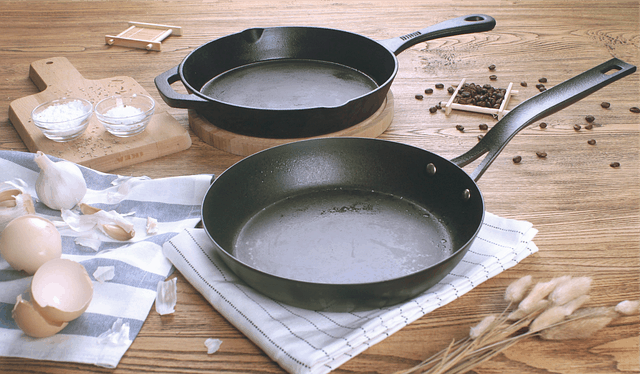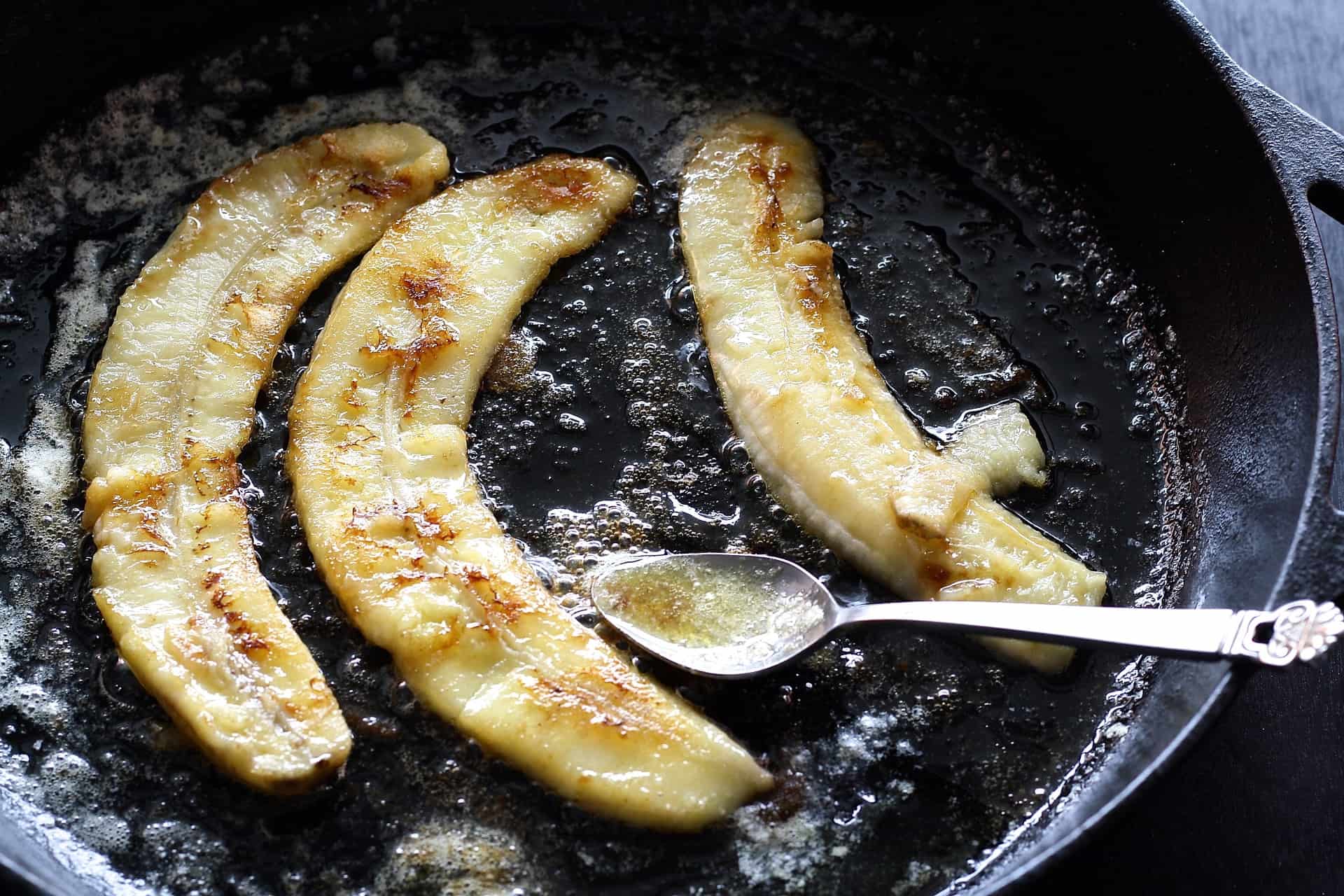Those that are new to cast iron cooking might believe that cast iron is pretty much indestructible due to its heavyweight and rugged feel.
However, the answer to “can you ruin a cast iron pan” might surprise you.
While cast iron is a very durable a resilient metal it is possible to ruin or damage a cast iron pan or skillet through improper care and neglect.
So now that we know that it possible to ruin a cast iron pan your next logical question might be “how do I not ruin my cast iron pan or skillet” and “what is the best way to care for cast iron”?
What Not to Do: 8 Ways to Ruin a Cast Iron Pan
Before we learn about the best ways to care for your cast iron skillet or pan it’s important to first go over what not to do with your cast iron pan.
Don’t Let Your Cast Iron Pan Rust
Rust is the number one enemy when it comes to cast iron and is one of the quickest ways to ruin a cast iron pan. To help avoid rust on your cast iron pan you want to keep your cast iron nice and dry and always follow the proper washing procedure that we will discuss below.
Also, never leave your cast iron pan out in the elements and when you’re done cleaning your cast iron don’t just let it drip dry instead dry it off right away with a towel.
Never Put Your Cast Iron Pan in the Dishwasher
Obviously, if excessive amounts of water are detrimental to cast iron one of the worst things you can do is stick your cast iron pan into the dishwasher. While the dishwasher is great for cleaning dishes and regular pots and pans, the dishwasher is no place for cast iron.
So while it might be tempting to put your cast iron pan in the dishwasher, don’t do it.
Never Let Your Cast Iron Skillet Soak
Another point worth mentioning is to never let your cast iron skillet soak in water. As with the above points you want to avoid excessive amounts of water when using cast iron because it can quickly cause your cast iron to rust ruining your cast iron skillet.
Stay Away from Acidic Foods
While cooking acidic foods on occasion is OK when using cast iron cookware you want to avoid continuously cooking acidic foods especially for long periods of time.
The reason for this is that acidic foods, especially over extended periods of time, can actually strip away the iron from the pan causing the food cooked on it to have an odd taste.
Don’t Leave Baked-on Food Stuck to Your Cast Iron
While we’ve all been there, you just enjoyed a great meal with your cast iron, it’s getting late and the last thing you want to do is clean up.
In those moments though it’s so important to protect the longevity of your cast iron to dig deep and clean your cast iron properly to remove any baked-on food before it hardens and sets up making it difficult to remove from the cast iron later.
Don’t OverHeat Your Cast Iron and Avoid Extreme Temperature Changes
While cast iron can safely be used over a campfire it’s best to avoid extreme heat or uneven heat when using cast iron as it can cause your cast iron pan or skillet to warp.
It also best to avoid extreme temperature changes when using cast iron to avoid damaging the metal or even potentially cracking the cast iron.
Examples of extreme temperature changes to avoid include shoving a cold cast iron pan directly into the extreme heat of a fire or pouring cold water onto a piping hot cast-iron skillet.
Keep Soap Away from Your Cast Iron
While it’s OK to wash your cast iron skillet when you first purchase it beyond that you want to avoid using soap to wash your cast iron pan or skillet.
This is because the chemicals in the soap can actually break down and remove the seasoning from your cast iron pan or skillet overtime.
Don’t Use Cast Iron for Seafood
Much like its a good idea to avoid excessive acidic foods when using cast iron its also a good idea to avoid seafood when cooking with cast iron or have a dedicated cast iron pan just for seafood.
This is because cast iron is a very porous metal and flavoring and odors from seafood can actually become trapped in the cast iron causing the next dish you have using your cast iron to have a fishy taste even though you thoroughly cleaned the cast iron after.

How to Take Care of a Cast Iron Pan
Now that we know what not to do when using cast iron cookware let’s take a look at the proper ways to take care of that cast iron pan so that it will last for years and years to come.
How to Clean a Cast Iron Pan After Cooking
One of the best ways to take care of a cast iron pan is to make sure you’re cleaning the cast iron properly as it is very easy to ruin a cast iron pan if your not cleaning it correctly.
Step By Step Instructions to Properly Clean a Cast Iron Pan
- Immediately after cooking dump any remaining fat or oil out of the pan before it has a chance to cool and coagulate.
- If you have really stuck-on food say from cooking eggs you can add warm water to the pan bringing the water to a boil and then use a spatial to scrape away the stuck-on food.
- Then wipe the pan out with a paper towel.
- Add a bit of salt to the pan to act as an abrasive with a bit of water and use a chain mail scrubber like this one on Amazon to remove any excess stuck-on bits of food from the cast iron pan.
- Then rinse out with water and dry
- Get the pan hot again to warm up the cast iron to remove any excess water.
- Rub canola oil over the entire pan while it’s still warm to season and protect the cast iron.
- Then let cool before storing.
If you still have questions or not quite sure about what to do for a particular step check out this great video on how to properly clean a cast iron pan.
Seasoning or Re-Seasoning a Cast Iron Pan
Another thing to keep in mind when caring for a cast iron skillet or pan is to make sure you maintain the proper seasoning on your cast iron cookware.
The seasoning on your cast iron pan is what makes the cast iron non-stick. Seasoning occurs when several layers of oil are baked into the cast iron creating a rust-resistant and non-stick surface to cook on.
While most new cast iron pans such as our favorite from Lodge that you can check out on Amazon by clicking here come pre-seasoned from the factory.
You always want to protect the seasoning by properly caring for your cast iron and occasionally re-seasoning the cast iron over time by applying canola oil to your cast iron after each use.
Proper Way to Store a Cast Iron Pan
As mentioned above the number one enemy for cast iron is rust so you want to make sure that your cast iron is absolutely bone dry before storing it away.
Next, if you plan on storing other pots or pans on top of your cast iron pan make sure to lay a paper towel sheet between the cast iron and any other items to help protect the surface and help to act as a sponge to wick away any moisture that might come in contact with the cast iron.
Restoring a Rusty Cast Iron Pan
Whatever you do don’t throw out a rusty cast iron pan because you can restore it with just a few simple steps listed below.
To begin with, most rust on a cast iron pan is what is often called profile rusting which is a mild layer of rust that can be felt or seen on the cast iron.
If this is the type of rust you have on your cast iron pan follow the below instruction to remove the rust and get your cast iron pan looking like new again.
Step by Step Instructions to Remove Rust from a Cast Iron Pan
- Use fine steel wool with a course grade of 0 or less to remove the rust from the cast iron by rubbing the fine stool wool across the cast iron until all of the rust is remove and you can see bare cast iron again. (Only use a fine stool to avoid scratching the cast iron and never use steel wool as part of your daily cleaning process for cast iron.)
- Wash the pan thoroughly after the rust removal.
- Dry the cast iron completely.
- Apply a layer of canola oil over the entire surface of the cast iron pan paying special attention to the areas you removed the rust from.
- Place the seasoned cast iron pan in the top rack of an oven upside down at a temperature of 350 degrees to bake in the seasoning.
- Then let cool and properly store the cast iron.
Want to learn how to use a cast iron skillet over a campfire? Check out our article “How to Use a Cast Skillet Over a Campfire“.

